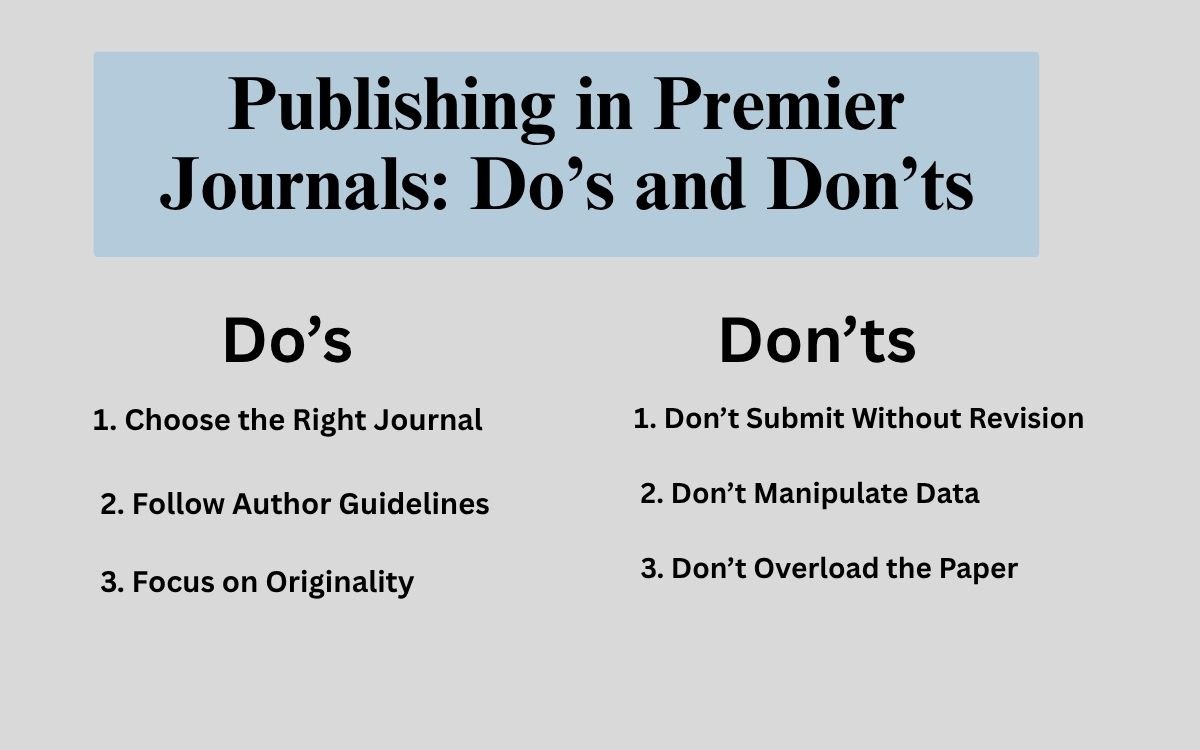Introduction
Publishing in a premier journal is a significant milestone in every researcher’s career. Top-tier journals are known for their rigorous peer-review process, high standards, and wide readership. Getting your paper accepted in such journals not only enhances your academic reputation but also opens doors for future collaborations and funding opportunities. However, many researchers struggle to meet these standards due to a lack of understanding of the publication process.
Here’s a simple guide on the do’s and don’ts that can help you successfully publish in a leading journal.
Do’s: What You Should Always Do
1. Choose the Right Journal
Before submitting your paper, take time to identify a journal that fits your research topic and methodology.
- Check the journal’s aims and scope.
- Review recent articles to understand the preferred writing style and research themes.
- Ensure the journal is indexed (e.g., Scopus, Web of Science, PubMed).
Tip: Submitting to the wrong journal is one of the most common reasons for rejection.
2. Follow the Author Guidelines Strictly
Every journal has specific requirements for formatting, referencing, and structure.
- Follow word limits, reference styles, and figure formats exactly.
- Use templates provided by the journal if available.
- Always double-check your abstract, keywords, and cover letter before submission.
Remember: Editors often desk-reject papers that ignore submission guidelines.
3. Focus on Originality and Contribution
Premier journals look for novel insights and real scientific value.
- Clearly highlight what is new about your study.
- Show how it advances existing knowledge or solves a real-world problem.
- Compare your results with previous studies to show improvement or innovation.
4. Write Clearly and Concisely
Good writing helps editors and reviewers understand your research quickly.
- Use short sentences and simple language.
- Avoid unnecessary jargon or complex expressions.
- Make sure your introduction builds a logical story leading to your objectives.
Pro Tip: Get your paper professionally proofread or use a language editing service before submission.
5. Be Ethical and Transparent
Ethical conduct is crucial in scholarly publishing.
- Do not plagiarize or reuse previously published material.
- Acknowledge funding sources and co-authors properly.
- Share data or code if the journal encourages open access or reproducibility.
6. Respond to Reviewers Professionally
Receiving reviewer comments is part of the process.
- Address each comment carefully and respectfully.
- Provide a clear explanation for any suggested changes you disagree with.
- Maintain a polite and professional tone, even if you feel the feedback is harsh.
This is often the stage where good papers get accepted.
Don’ts: What to Avoid
1. Don’t Submit Without Thorough Revision
Never send a first draft. A poorly edited manuscript gives a negative impression.
- Revise multiple times.
- Ask peers or mentors for feedback.
- Use tools like Grammarly or Turnitin for grammar and plagiarism checks.
2. Don’t Manipulate Data
Fabricating, falsifying, or selectively reporting data can lead to permanent blacklisting.
- Always present honest results.
- If there are limitations, discuss them openly in the paper.
3. Don’t Overload the Paper
Too many tables, figures, or unnecessary details can make your paper confusing.
- Focus on the key findings that support your objectives.
- Move supplementary materials to appendices or online resources.
4. Don’t Ignore Citations
Not citing relevant work can make your research appear weak.
- Cite recent and high-quality papers from reputable journals.
- Avoid self-citation unless it’s necessary.
- Make sure every reference mentioned in the text appears in the reference list.
5. Don’t Give Up After One Rejection
Even the best researchers face rejections.
- Use the reviewers’ comments to improve your paper.
- Revise and submit to another suitable journal.
- Persistence is key in academic publishing.
Conclusion
Publishing in a premier journal requires patience, precision, and professionalism. By following these do’s and avoiding common pitfalls, you can greatly increase your chances of acceptance. Remember that every rejection is a step toward improvement. The goal is not just to publish but to contribute meaningfully to your field.

Leave a Reply